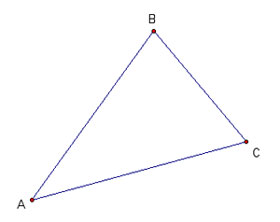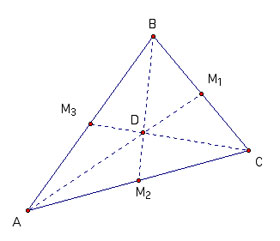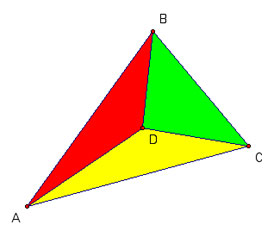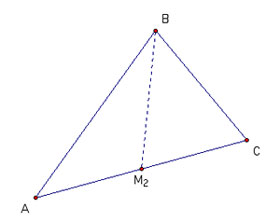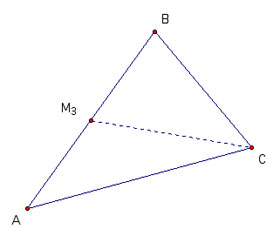Now we need to connect the centroid to
each of the vertices to create
the segments for the sides of each of our three triangles.
So we have that Area(ADB) = Area(BDC) =
Area(CDA) and that Area(ADB) + Area(BDC) + Area(CDA) = Area(ABC)
We know this to be true because the centroid is formed by the
intersection of the three medians of the triangle. We know that
the median of a triangle divides the triangle in half by connecting one
vertex to the midpoint of the opposite side. So, if we look at
the median AM
1, we know that Area(AM
1B) = Area(AM
1C)
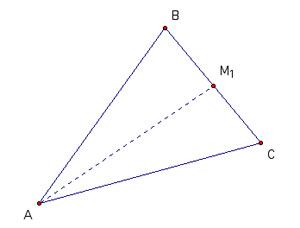
Now the same is true for the area of triangles BM
2C and BM
2A
as well as
CM
3A and CM
3B.
Now if we look at the centroid, D, of triangle ABC, we know that each
of our small triangle ADM
3, M
3DB, BDM
1,
M
1DC, CDM
2, and M
2DA are all
1/
6 the area of our triangle ABC.
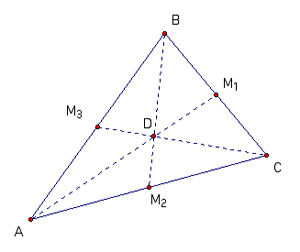
Therefore, when we combine any two of these triangle, they are
1/
6
+
1/
6 =
1/
3 the area of
triangle ABC. So we must have that each
triangle ADB, BDC, and CDA are
1/
3 the area of
the triangle ABC.
Now we will look at the second method of trisecting the area of a
triangle. For this method we construct two segments parallel to
the base of our triangle ABC in order to create three regions, one
triangle and two trapezoids, that are each equal in area, and are each
1/
3
the area of triangle ABC.
We begin by constructing a triangle that is
1/
3
the area of the original triangle ABC. We know that this triangle
will be similar to our original triangle ABC by AAA. So we must
have that the ratio of the sides of our original triangle ABC to the
new triangle is sqrt(3):1. So we can begin our construction or
this new triangle by first
constructing a 30-60-90 triangle where one leg of the 30-60-90 triangle
is equal in length to one segment of triangle ABC. We will do
this because we know that the ratio of the long leg to the short leg is
sqrt(3):1.
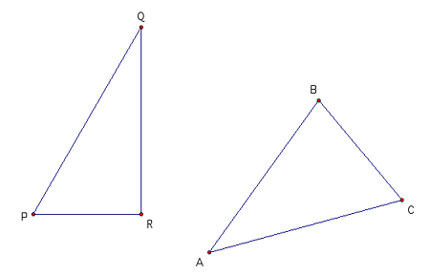
In the above figures, we have that QR = AC, therefore the ratio of PR
to AC is 1:sqrt(3). So now we need to construct a circle around
the point B with radius equal to the length or PR. The point of
intersection of the circle about B and the segment AC is one vertex of
our new triangle. We will call this point D. So now we know
that the ratio between AB and DB is 1:sqrt(3). Finally we need to
construct the point E so that DE is parallel to AC.
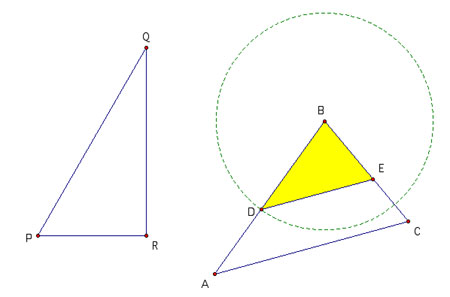
Now we have that triangle DBE is
1/
3 the area of
triangle ABC.
Next we need to construct the two trapezoids, each of which are also
1/
3 the area of triangle ABC. This means we
want to divide the polygon ADEC in half. So we want to construct
a point G such that the ratio between BG and BD be
sqrt(2):1. We know, from the properties of a 45-45-90 triangle,
that if we construct a 45-45-90 triangle with leg length equal to BD we
will be able to construct a circle about the point B so that its radius
is equal to the hypotonuse of the 45-45-90 triangle giving us that the
ratio between BG and BD is sqrt(2):1. Then we can construct a
segment through the point G parallel to the base, AC, of the original
triangle ABC. So now we have constructed the two trapezoids GDEH
and AGHC, both of which are
1/
3 the area of the
original triangle ABC.
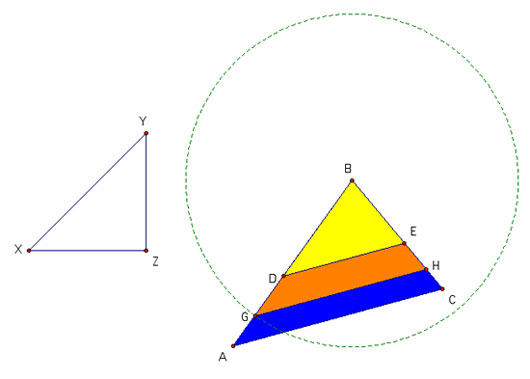
Finally we have that each trapezoid, AGHC and GDEH, as well as the
triangle DBE are
1/
3 the area of the original
triangle ABC.
To view an interactive GSP sketch of the first method of trisection
click
here.
To view an interactive GSP sketch of the second method of trisection
click
here.
